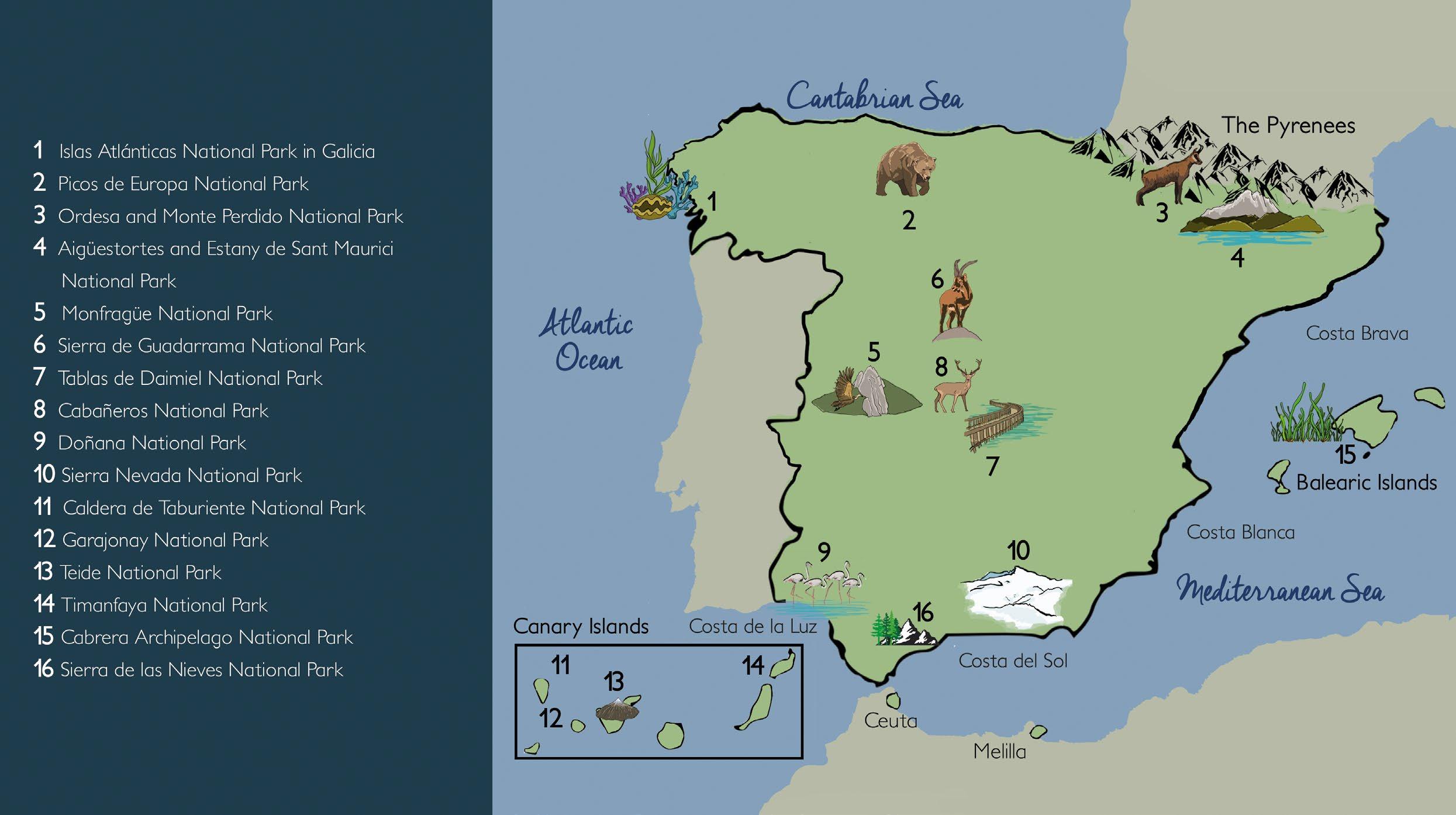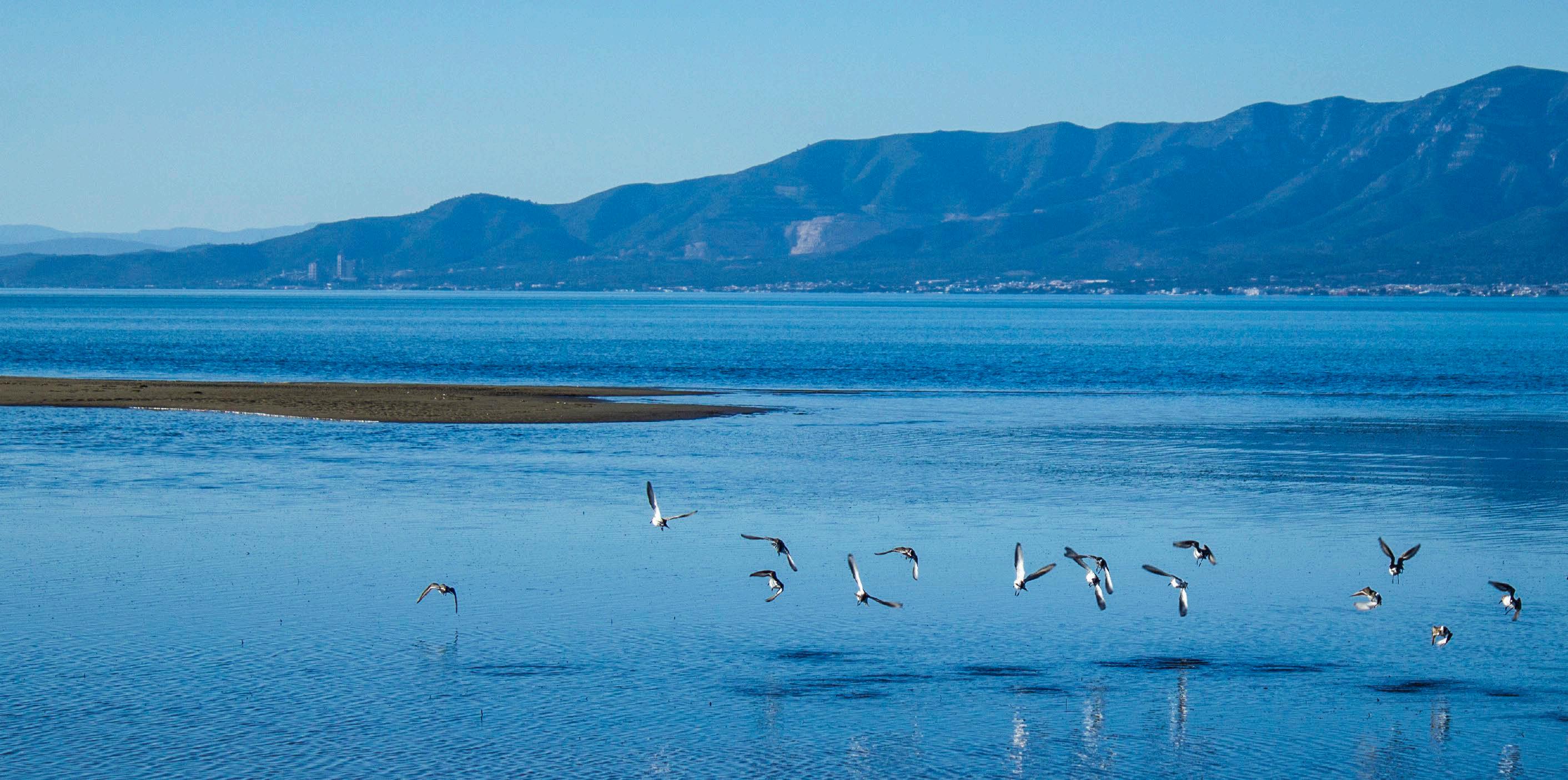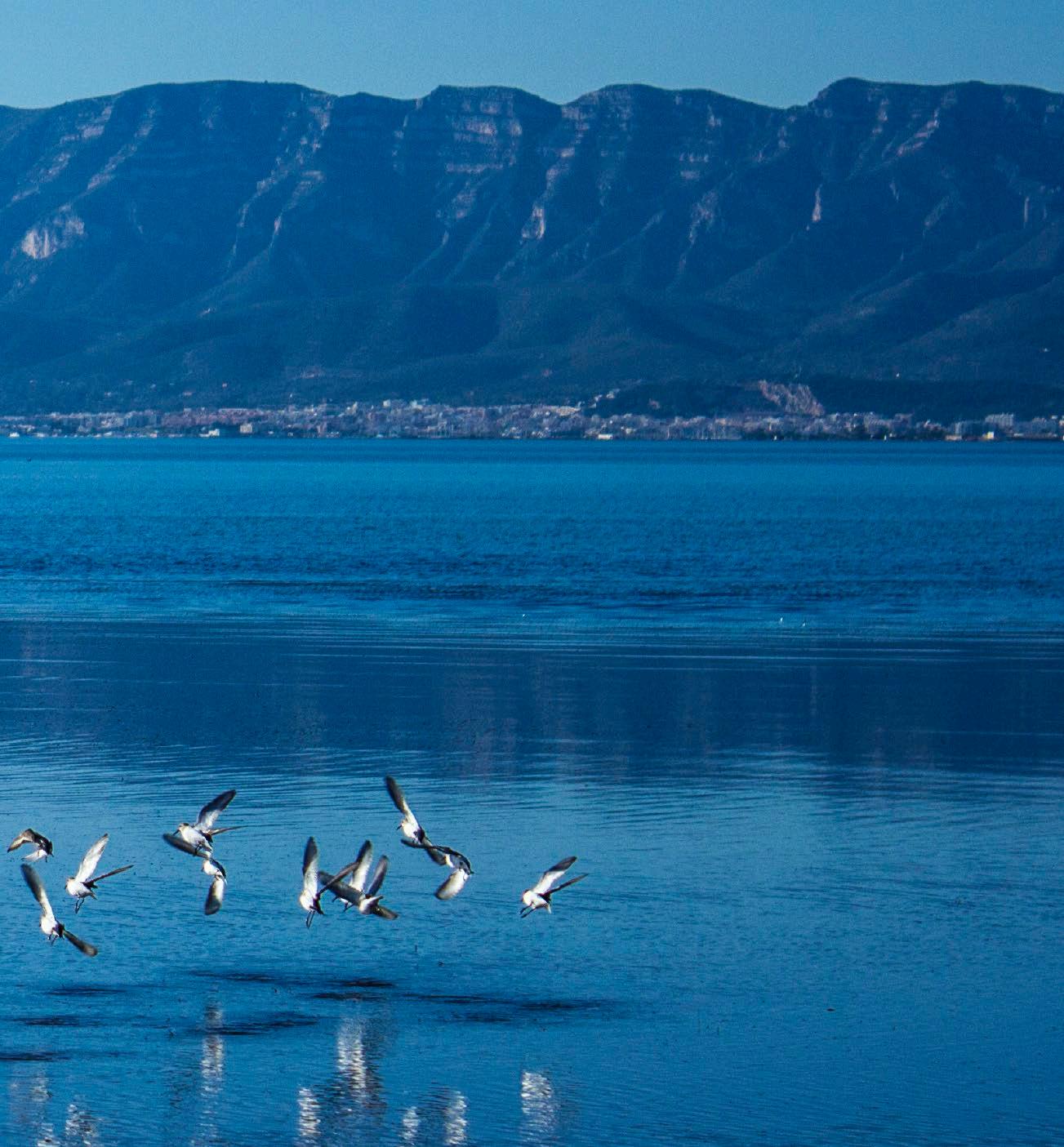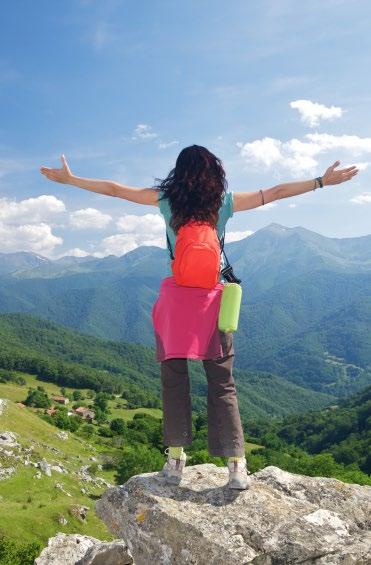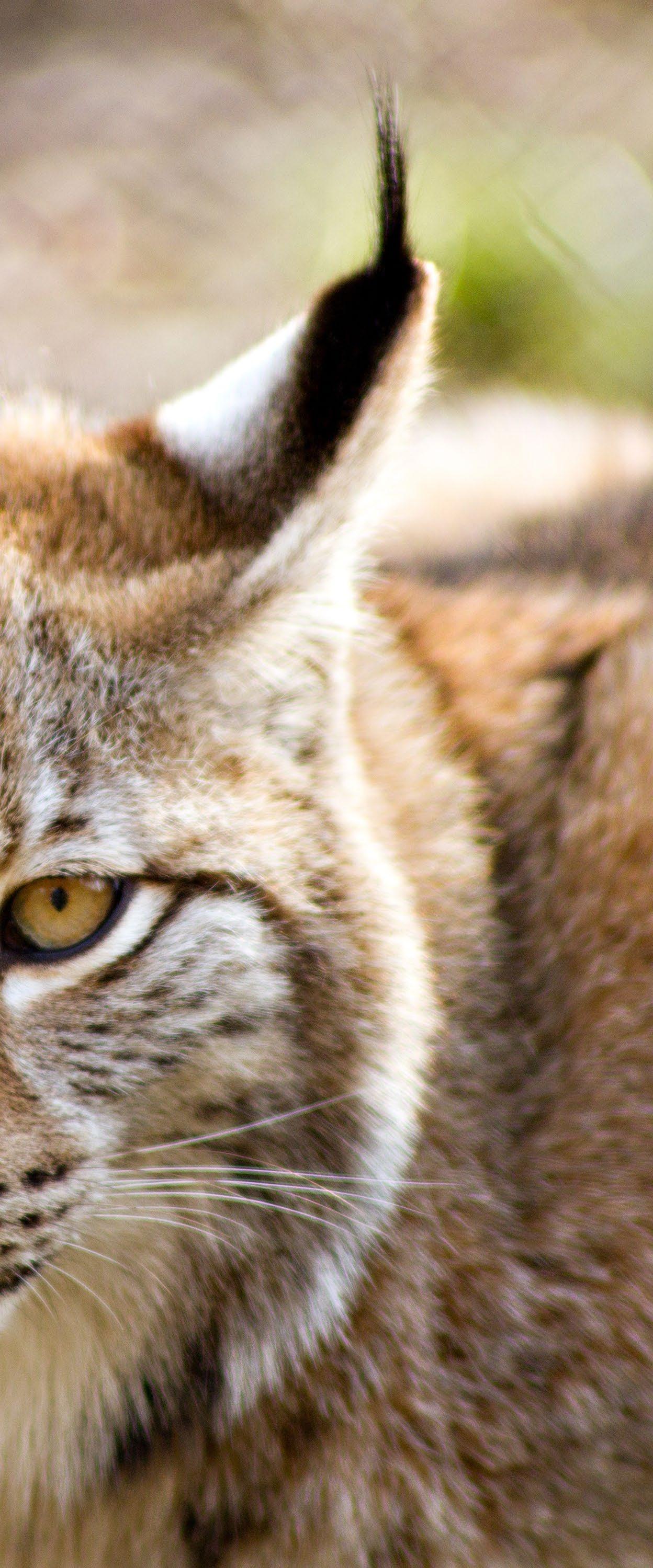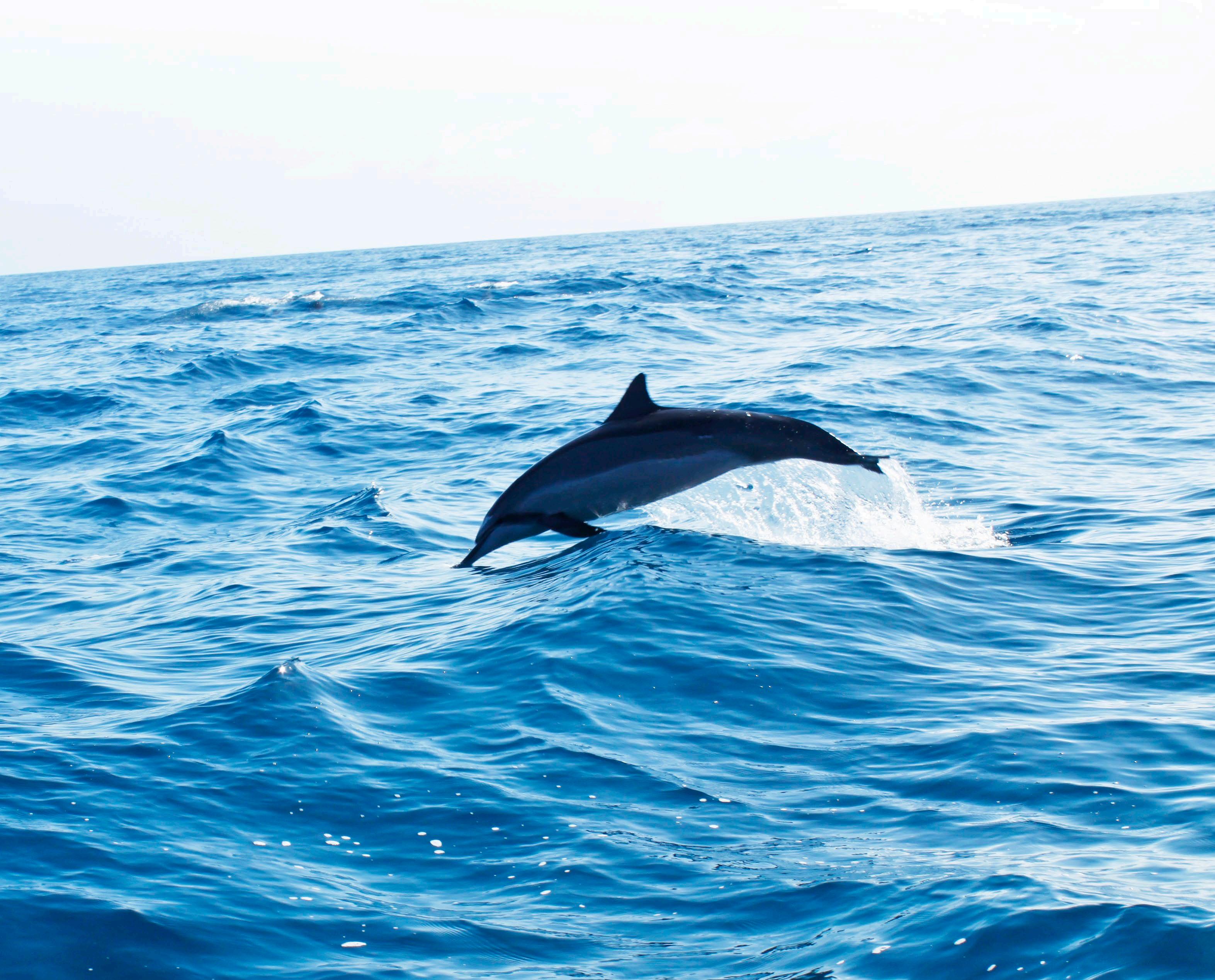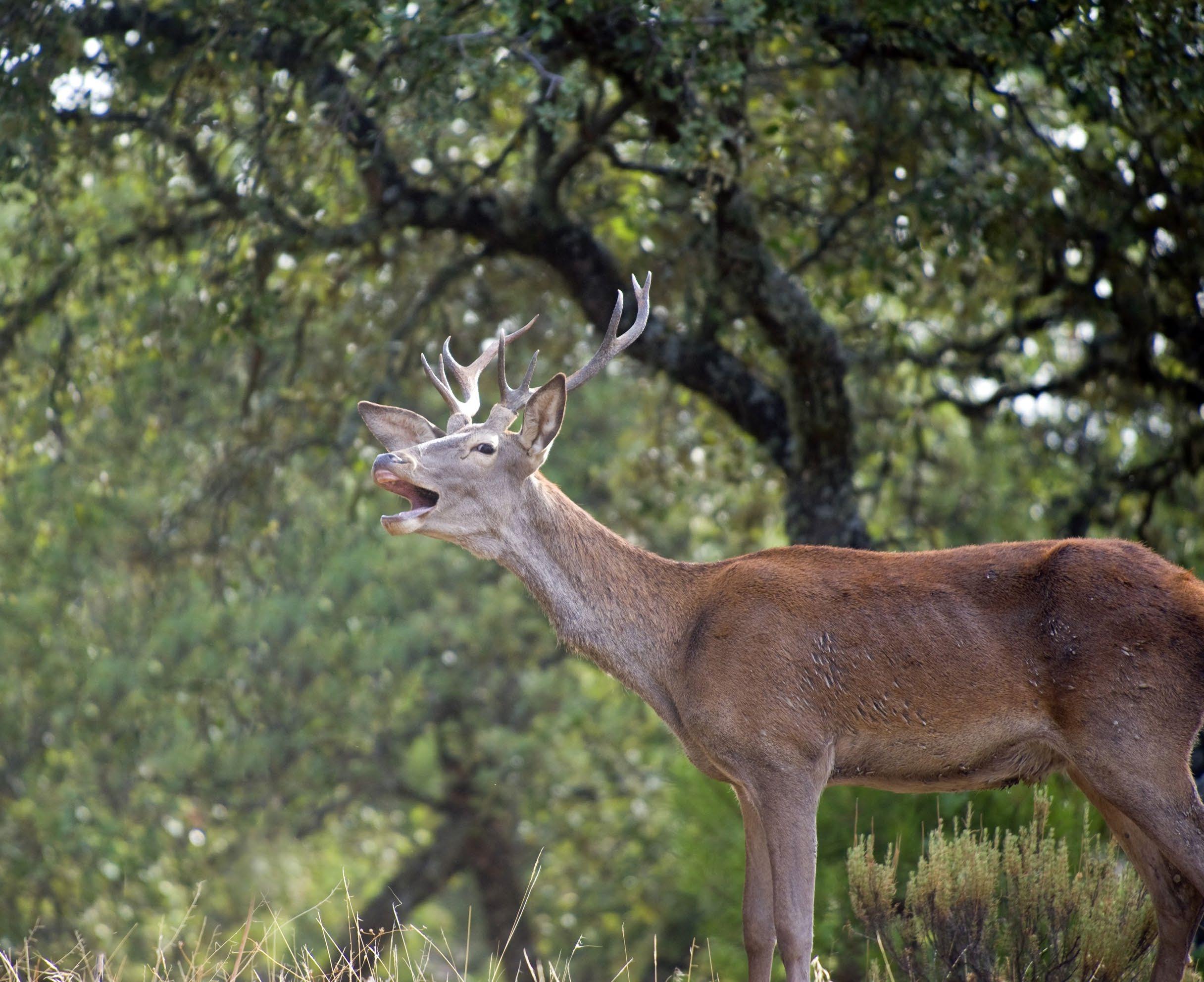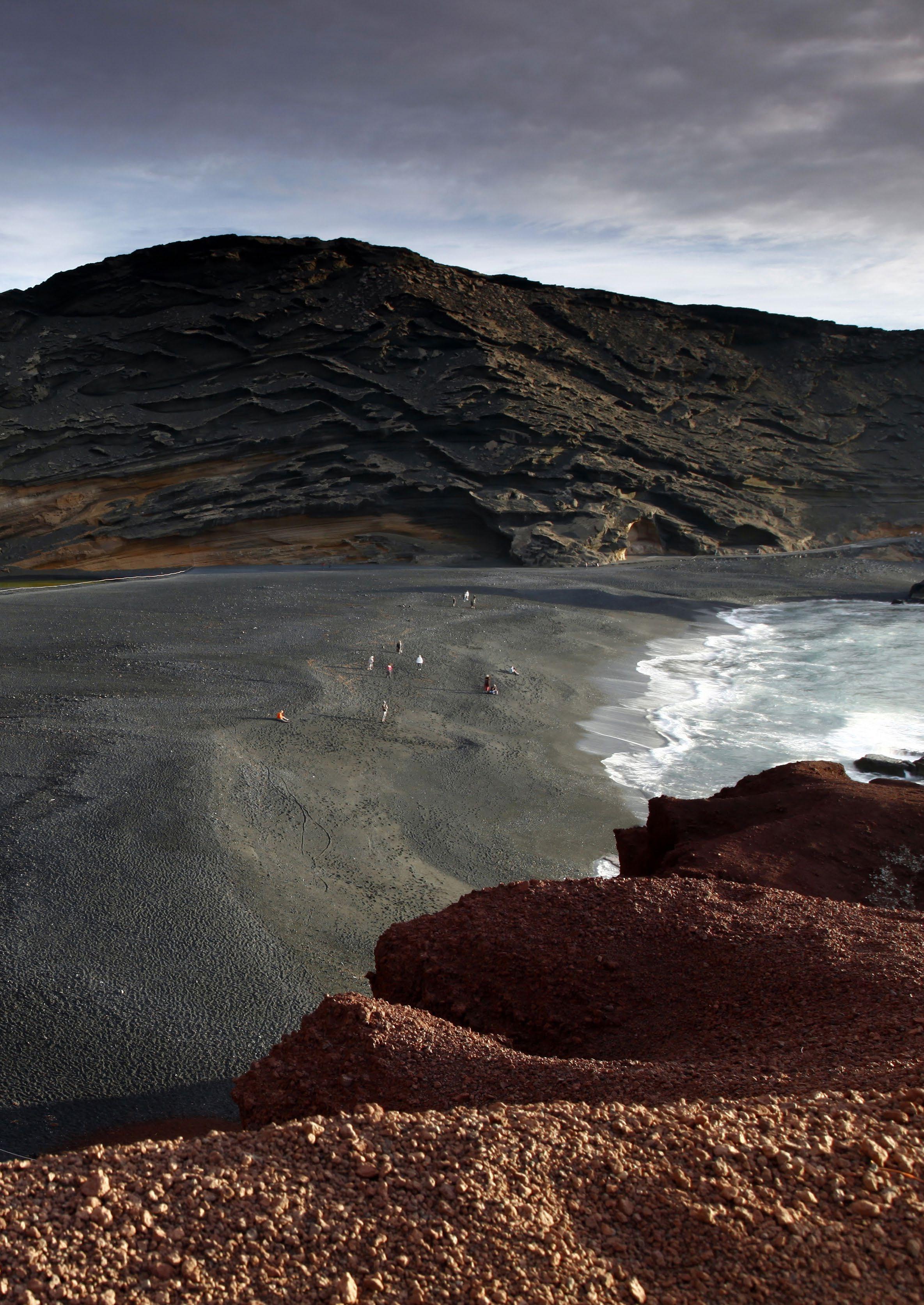OBSERVING WILDLIFE AND VEGETATION
The biological diversity of Spain's natural heritage is unparalleled. There are over 500 species of birds and iconic, threatened species just waiting for you. Come and gaze at the stars from incredible places and take a geobotanical tour to discover the most varied flora in the European Union.
These are just a few of the amazing experiences you can enjoy in Spain right in the heart of nature.
BIRD WATCHING
Bring your binoculars and enjoy amazing landscapes and a great variety of birds. Located in a major migration route, thousands of species of birds choose Spain each year to breed and to rest. A true birdwatcher's paradise.
Wander the Mediterranean forest in the Cabañeros National Park (Ciudad Real and Toledo), home to the Spanish imperial eagle, the black vulture and the robin. Near there, in the La Mancha Wetlands Biosphere Reserve, you can
LAGUNAS DE RUIDERA NATURE RESERVE CIUDAD REAL
visit the Lagunas de Ruidera Nature Reserve (Albacete and Ciudad Real), nesting areas for red-crested pochards, mallards and purple herons. You can also explore the Hoces del Duratón (Segovia), an amazing landscape where the river has created incredibly-shaped walls and caves. There you can rent a kayak and watch griffon and Egyptian vultures pirouetting across the sky.
In spring you should visit the Villafáfila Lagoons (Zamora) and the Plains of Cáceres and Sierra de Fuentes in Extremadura, where you'll find the heaviest flying bird in the world, the great bustard. See the griffon vulture's
extraordinary flight in the Monfragüe Biosphere Reserve and National Park, a Special Protection Area for Birds (SPA). This is also the natural habit for other species like the black stork and the short-toed snake eagle.
In the Doñana National Park (Huelva, Cádiz and Seville), the largest wetland in Europe (World Heritage and Biosphere Reserve), you'll see our most beloved indigenous species, the Spanish Imperial eagle, along with other birds like Egyptian vultures, flamingos and white-headed ducks. Take a route by on foot or horseback through this birdwatcher's paradise, a mosaic
a DOÑANA NATIONAL PARK HUELVA
of ecosystems used by over six million migratory birds each year. A few kilometres lies the Strait of Gibraltar, a bridge between Spain and Africa and where thousands of birds pass each year to spend the spring and summer in Europe after wintering in Africa.
All along the Mediterranean coast there are incredibly beautiful wetlands like La Albufera in Valencia. These are breeding grounds for aquatic birds like the great cormorant and the red-crested pochard which stop over in the area while migrating.
In the Tierras del Ebro Biosphere Reserve, the Ebro Delta in Tarragona is a unique landscape of great plains and rice fields and there are numerous lookout points in strategic locations. From here you can observe the great flocks
of flamingos which inhabit the lakes for most of the year. Visit the Deltebre Ecomuseum to learn all about this ecosystem which is vital for Spanish wildlife and vegetation.
Enjoy some spectacular birdwatching on the unique Belchite steppes (Zaragoza) where you can see birds specialising in this habitat. On a visit to the El Planerón Reserve you should go up to the lookout point to see species like pin-tailed the sand grouse, Dupont's lark and the lesser short-toed lark.
To see griffon vultures and lammergeier, in the Ordesa-Viñamala (Huesca) Biosphere Reserve, go to the Ordesa y Monte Perdido National Park (its Pyrenees-Monte Perdido area is World Heritage), or the spectacular canyons of Foces de Lumbier and Arbayún in
a EBRO DELTA TARRAGONA
NATURE WATCHING IN SPAIN
Navarre. Its privileged location between the Cantabrian sea, the Ebro valley and the Pyrenees makes this region an unbeatable destination for watching rock and forest dwelling birds.
Forests of holm, Portuguese and Pyrenean oak and beech cover the rocky Peñas de Iregua, Leza and Jubera gorges in La Rioja, a Biosphere Reserve and an ideal habitat for Egyptian vultures, falcons, eagles and eagle-owls. This area also has the magnificent Leza River Canyon (almost 700 metres high) with a splendid lookout point.
Get your notebook ready and travel to Galicia to explore the Mañón district, the Ortigueira Estuary and Estaca de Bares, where the Atlantic Ocean meets the Cantabrian Sea, the northernmost point
on the Iberian peninsular. This migratory corridor is frequented by northern gannets, shearwaters and puffins and there are incredible cliffs from which you can watch thousands of birds flying off to their wintering sites.
Spain's two archipelagos, the Canary Islands in the Atlantic and the Balearic Islands in the Mediterranean, provide shelter for large flocks of sea birds and beautiful indigenous species. They have extraordinary biodiversity, like the great forests in Tenerife and the north of Mallorca.
If you'd like to learn more about birds, then all over Spain you'll find numerous courses and outings with experienced guides.
a ORDESA Y MONTE PERDIDO NATIONAL PARK HUESCA
ADVENTURES WITH BIRDS FOR CHILDREN
We'd like to suggest some of the best places with excellent facilities and easy access to go birdwatching with children: the Lozoya Valley (Madrid), the Santoña marshes, (Cantabria), the Alava wetlands (Álava) and the Aiguamolls de l’Empordà marshes (Girona). Together with your children you can learn how
to distinguish different species, identify footprints and build shelters and food tables for birds.
There are a large number of companies all over Spain specialising in routes, ringing workshops and handicrafts for families.
L www.seo.org
MAMMALS IN THEIR NATURAL HABITAT
Come and enjoy a wonderful experience, track protected wildlife. This type of tourism is committed to sustainability and encourages the protection of endangered species. Here are a few suggestions.
IBERIAN WOLF
Witness for yourself this stealthy and elusive species and interpret tracks and sign with the help of expert guides. To see the Iberian wolf in action you should visit the Sierra de la Culebra (Zamora). That's where you'll find the largest concentration of wolves in Spain.
Near the town of Robledo de Sanabria you'll find the Iberian Wolf Visitor Centre, where a number of wolves live in semi-freedom. You can catch sight of them from the watchtowers all around the area. If you'd rather see them in the forests and valleys you'll need the help of expert guides.
Further north, on the Cantabrian Ridge, you can hear wolves howling at night. In the Somiedo Nature Reserve and Biosphere Reserve (Asturias), you can follow itineraries like the Los Lagos Route and follow their tracks through areas like the Sierra del Cuera If you wait until dusk in the valleys in the Saja-Besaya Nature Reserve (Cantabria) you can enjoy the spectacle of a pack with its cubs coming down the mountainsides.
In the fascinating landscape of the Picos de Europa (León, Cantabria and Asturias), the largest national park in mainland Spain and a Biosphere Reserve, there are amazing lookout
IBERIAN WOLF
SOMIEDO NATURE RESERVE ASTURIAS
points overlooking the meadows and forests which are the ideal ecosystem for the wolf. Take a position high up in places like the Cosgaya hills, in the Liébana Valley (Cantabria) and you may be able to enjoy a truly magical encounter. Can you hear the call?
L www.parquenacionalpicoseuropa.es
b PICOS DE EUROPA CANTABRIA
BROWN BEAR
The largest land mammal in the Iberian Peninsula is one of the most threatened species in Europe. Their population in the Cantabrian Ridge and the Pyrenees is estimated to be around 450, so if you want to see them in the wild we advise you to seek the help of professional guides.
You can follow the Bear Route on foot or by bike as you cross mountains and gorges in Asturias where you'll discover the natural habitat of this protected species. One of the main attractions for this route is seeing bears in a fencedoff area halfway along the trail.
The Somiedo Biosphere Reserve features high peaks, lakes, forests, mountain pastures and meadows and is an ideal habitat for species in danger of extinction like the brown bear, the wolf and the Cantabrian capercaillie.
This protected area has remained unchanged over the centuries. This paradise for hikers has interesting features like the park's Visitor Centre, located in Pola de Somiedo, an educational and leisure facility for all the family.
The Brown Bear Foundation also has a Visitor Centre in this important refuge for the north of Spain's most iconic large mammal species. They organise numerous guided tours.
In the Fuentes del Narcea, Degaña e Ibias Natural Park and Biosphere Reserve, especially in the beech and oak forests in spring and autumn, you'll get to see foxes, otters, roe deer... and the king of the forest, the Cantabrian brown bear.
IBERIAN LYNX
Enjoy the incredible experience of tracking the world's most endangered feline. Its only habitat is the Iberian Peninsular where the population is recovering thanks to a successful programme of breeding in captivity and release into the wild.
There are currently about 755 in Andalusia and although they are very difficult to spot, with a lot of patience, a bit of luck and some help from local experts you may get to see them in the wild.
In the Doñana National Park you'll see them in the game reserves and marshlands of this Biosphere Reserve and World Heritage Site, which are the lynx's ideal habitat. You can take a photographic safari organised by a specialist company so you can get the photo you dreamed of, or visit the Lynx Observatory in Acebuche, in Huelva, a breeding centre which shelters a male and a female. Find out what their daily life entails and enjoy an exhibition and activities relating to the Doñana ecosystems.
The Dehesas Biosphere Reserve in the Sierra Morena, is home to the greatest number of Iberian lynxes in Spain. Follow the signs and tracks in search of this elusive feline, which uses the scrubland and oak trees to hide and to hunt its favourite prey: rabbits. A comprehensive ecosystem with trails where you'll find signs indicating the presence of the Iberian lynx.
IBERIAN LYNX
You can sometimes see lynx kittens, especially in winter. Early in the morning and at dusk are the best times to get what will be an unforgettable souvenir of your journey.
In this same region, the Sierra de Cardeña y Montoro Nature Reserve is another place where you can enjoy this unique sight.
L www.andalucia.org
DOÑANA NATIONAL PARK HUELVA
SEA LIFE
With nearly 6,000 kilometres of coastline divided between two seas and one ocean, Spain is ideal for observing marine wildlife. With numerous specially protected reserves, you'll be able to enjoy wonderful underwater seascapes full of marine life.
Swim alongside dolphins, pilot whales and, with a bit of luck, rorquals or finback whales (the second largest whale after the blue whale), killer whales and sperm whales in Tarifa, near the Strait of Gibraltar. Several companies organise outings and ecotourism tours in this key area for the migration of up to seven cetacean species. Some stay in this area all year round and are quite happy to swim up close to boats. The Atlantic and the Mediterranean will provide you with unforgettable experiences.
Another good place to sight these creatures is off the south west coast of the islands of Tenerife and La Gomera (Canary Islands), a Biosphere Reserve. Here you can find up to twenty different species, featuring the common dolphin, the rough-toothed dolphin and the pilot whale.
Other areas where you may see cetaceans in the wild and take part in activities involving their sighting are the coasts of Asturias, Galicia, the Basque Country-Euskadi and the Balearic Islands.
There is a secret treasure hidden under the turquoise-blue waters around the Balearic Islands: the fields of posidonia oceanica seagrass of the Salines Natural Park (Ibiza and Formentera),
DOLPHIN TARIFA, CÁDIZ
declared a World Heritage Site. This plant is responsible for the transparency and colour of the water, and it is a key factor in oxygenating and maintaining the quality of the marine ecosystem.
Posidonia oceanica seagrass, said to be the oldest living being on earth at around 100,000 years old, extends for eight kilometres around the Island of Formentera. In this habitat, in the Ibiza and Formentera Ses Salines Nature Reserve, over 400 species of plants and 1,000 species of marine animals feed and breed. The seagrass is a hiding place for numerous creatures such as starfish, sea-horses and sea urchins. As dropping anchor here is severely restricted, the best way of enjoying this incredible underwater forest is snor-
The turquoise-blue waters around the Balearic Islands are due to the fields of posidonia oceanica seagrass, declared a World Heritage Site by the UNESCO.
kelling from one of Formentera's idyllic beaches, like Ses Illetes and Llevant.
Along the coast of the Cabo de GataNíjar Biosphere Reserve (Almería), you'll also find a large extension of perfectly preserved Posidonia meadows. Try a night dive at the Punta del Castillo or dive amongst archaeological remains in the Cala de San Pedro.
Visit the Islas Columbretes Marine Reserve (Castellón) where you'll find spectacular invertebrates like sea fans and red coral. In the deeper waters you'll find some of the few fields of laminaria rodriguezii kelp remaining in the Mediterranean.
Relax with your snorkel in the Cabo de Palos Marine Reserve in Murcia, a coastline with peaceful coves and crystal clear water where there is an abundance of caulerpa seaweed. For a little more excitement, try the Islas Hormigas and explore the hidden mysteries of the Sirio, a ship-wrecked transatlantic liner, surrounded by spectacular ocean sunfish.
In Asturias, 65 kilometres from the coast of Ribadesella, there is a huge mountain submerged in the Cantabrian sea and known as El Cachuco, the name which they also give locally to the red bream. This extraordinary geological formation, the first Protected Marine Area (AMP in Spanish) declared in Spain, rises sharply from a depth of 4,000 metres and is home to a unique biodiversity.
The Canary Islands are another haven for lovers of diving. On the Isla de Hierro, a Biosphere Reserve, you'll feel just like Jacques Cousteau. You'll find most of the main diving centres in La Restinga, the southernmost town in Europe. There you have incredible dives like that to El Bajón, a beautiful undersea volcano where you'll see Bentfin devil rays, protected species like the Longspine African angler and the great whale shark.
Still in the Canary Islands, La Isla de La Palma, a Biosphere Reserve, is ideal for learning to dive or relishing in your passion for submarine life. It has the best possible conditions because of the crystal-clear water and the exceptional climate. There you can see the undersea monument of Malpique, a majestic basalt tower covered in black coral, and if you're lucky you might come across a beautiful sea loggerhead turtle.
Other places where you can explore Spain's magnificent seabeds are Cap de Creus and the Medes Islands (Girona) and the Atlantic Islands National Park (Galicia).
DEER RUT
Another great spectacle provided by Spain's wildlife. At the end of September and the beginning of October you not only have the incredible explosion of autumn colours, in many parts of the country you can witness the mating ritual of the red deer.
The guttural sounds echoing round the valleys and forests are a sign that the mating season has arrived for this majestic animal. The antlers which have grown during the spring and summer are now used in thrilling battles to establish dominance.
You can witness this extraordinary phenomenon in numerous parts of Spain. One of the most beautiful is the Sierras de Cazorla, Segura y Las Villas Nature Reserve (Jaén), a Biosphere Reserve. There you can here the rutting of these elusive herbivores while canoeing on the Tranco Reservoir. You can also climb up to the Félix Rodríguez de la Fuente lookout point, where you'll have a wonderful panoramic view of adults and fawns.
The Los Alcornocales Nature Reserve, between the districts of Algeciras and Jerez, is ideal for observing another species, the fallow deer and hearing its
most unusual rutting call in October. The best places for this are La Sauceda and the Aljibe peak or the Montenmedio Nature Reserve on the outskirts of Vejer (Cádiz). It's also a good excuse to tour the White Villages, with white-washed houses and ancestral traditions relating to hunting and agriculture.
Also in Andalusia. the Hornachuelos Nature Reserve (Córdoba) provides an extraordinary setting for the rutting season. It's best to go at dawn or at dusk, and take your binoculars so as not disturb them and prevent them from running away.
b SIERRAS DE CAZORLA, SEGURA Y LAS VILLAS NATURE RESERVE JAÉN
You'll find the largest herds of these animals in the Montes de Toledo, in Castile-La Mancha. There you have the Cabañeros National Park , with the largest extension of forest and scrubland in the Mediterranean. The park itself organises guided tours in off-road vehicles to bring you to the key rutting locations, and there are also educational tours as well as a route on horse-back.
Other great places for witnessing deer rutting are the Sierra de Cameros (La Rioja), the Sierra de San Pedro (Cáceres), the Boumort Nature Reserve (Lleida) and the Fuentes Carrionas y Fuente Cobre - Montaña Palentina Nature Reserve (Palencia).
You'll also find large herds of this Iberian species in areas with the greatest biodiversity, like the Sierra de la Culebra, Monfragüe, Doñana and Picos de Europa.
a CABAÑEROS NATIONAL PARK CIUDAD REAL - TOLEDO
GEOPARKS
Discover the extraordinary diversity of landscapes in Spain in its 15+ geoparks. These territories have the backing of the UNESCO and display the 4,600-million-year history through its geological evolution. They are distributed all over Spain and encourage ecological awareness, appreciation for geo-diversity and teach about palaeontology.
CABO DE GATA NATURE
One of the most surprising is the Costa Vasca, between Deba, Zumaia and Mutriku. Follow a route with fifteen lookout points where you'll see spectacular cliffs and a unique formation of superimposed layers of rock, called flysch. This amazing phenomenon gives us the chance to discover some of the events and cataclysms that took place on Earth millions of years ago. You can also travel along the Basque coast by boat and get a unique perspective of the cliffs and the rugged Cantabrian coast.
Inland you'll find karst formations full of sinkholes and grottoes created by the erosion of the limestone rock. In Zestoa (Gipuzkoa), you can visit a replica of the Ekain cave, a UNESCO World Heritage Site where you'll learn about the cave paintings and how our remote ancestors lived.
Can you imagine seeing rocks that are normally found 70 km underground? You can do it at the Cabo Ortegal geopark in Galicia (A Coruña). Another must-see site to understand human development from prehistoric times is the Montañas do Courel geopark (Lugo), featuring viewing points, museums, interpretation centres and 189 km of trails to explore.
Sobrarbe (Huesca) is an incredibly beautiful area with geological treasures hidden amongst the rocks. You can take part in photographic competitions and enjoy guided tours through the region's megalithic monuments.
The Las Loras Geopark lies in the north of the provinces of Palencia and Burgos, and consists of a limestone moorland plateau (locally called "loras") and incredible river canyons. There you can take part in field trips, workshops and tours and explore Pre-Roman forts and megalithic sites.
Further east you'll find the Orígens, with an extensive, internationally renowned, geological heritage, and the Central Catalonia Geopark, with surprising rock formations like the Cardona salt mountain. You can go inside where you'll discover the different folds and veins of a great variety of mineral deposits hidden in the galleries.
Visit the Aliaga Cultural Park (Teruel) and explore the network of pathways through a landscape of mountains, crests and gorges. You'll find two important sets of cave paintings (in Santoles and in the Alto Maestrazgo) with examples of Levantine and Iberian schematic cave art styles.
Visit an open-air museum with volcanic calderas and domes, lava flows and fossil reefs in the volcanic mountains of Cabo de Gata-Níjar (Almería), a Biosphere Reserve. Explore the Gorafe desert or climb up to the Fin del Mundo viewing point to enjoy an amazing panorama of the Granada geopark. Without leaving Andalusia, you can follow the route of the ammonoids, spiral-shelled molluscs millions of years old, in the Sierras Subbéticas or visit a site with prints of jellyfish in the Sierra Norte de Sevilla Travel back in time to the beginnings of life on European continent.
a ORDESA Y MONTE PERDIDO NATIONAL PARK HUESCA
The Molina Alto-Tajo (Guadalajara) is the largest geopark in Europe and where you'll find remains of civilisations from ancient times and extraordinary landscapes like the Valle de la Mesa valley and the Ravine of the Virgen de la Hoz. The Almadén Mine sites or the Puertollano carboniferous beds are some of the jewels of the Calatrava Volcanoes (Ciudad Real), where you can also admire the majestic maar (lagoon formed when the volcano explodes underground) in La Posadilla. In Extremadura, the Villuercas-IboresJara region is a unique environment where there are numerous trails and itineraries. The abundance of water makes it ideal for sports like canoeing which gives you a thrilling perspective of the magnificent surroundings.
The volcanic origin of the Canary Islands is the determining factor behind the landscape in the Lanzarote and Chinijo Archipelago Geopark, perfect places for observing geological formations which seem to come from another planet. The beautiful contrast between the white salt of the Janubio Salt Pans and the black volcanic sand is one of the most beautiful sights when you visit the island of Lanzarote, a Biosphere Reserve.
In El Hierro, in October 2011, there was a submarine eruption in El Mar de Las Calmas, just two miles off the coast of the town of La Restinga, which made the island's seabeds even more wonderful.
L www.geoparques.es
a MOLINA - ALTO TAJO GEOPARK
GUADALAJARA
El Hierro is a Biosphere Reserve and has the highest density of volcanoes and great biodiversity both above and under the sea.
STARGAZING
The night sky in Spain provides some of the best conditions in Europe for stargazing. Here there are over 50 Starlight destinations, with excellent conditions for observing the starry sky and enjoying tourist activities based on this resource, as well as 15 Starlight Reserves.
You'll be amazed at the starry sky in La Palma (Canary Islands), a Biosphere Reserve. Climb up to the El Roque de los Muchachos Observatory to enjoy an incredible experience. As the sun goes down, a blanket of clouds surrounds the island below the mountain peaks which gives you an amazing feeling of walking in the sky. The ideal conditions in the Canary Islands provide other fas-
cinating opportunities for gazing up at the heavens, like the El Teide National Park (Tenerife), World Heritage, and numerous lookout points on the islands of Gran Canaria and Fuerteventura, both Biosphere Reserves.
In the Pre-Pyrenees in Lleida, visit the Montsec Astronomy Park where you can use the telescopes to observe the planets nearest to the Earth, and if you
Starlight is an international certificate for protected areas where the clarity of the night sky is part of their natural heritage.
The peaceful region of Los Pedroches in Córdoba is a strategic point for beginning an astronomic route. There are excellent lookout points surrounded by olive groves and pastures where you can observe the sky with the naked eye. If you'd rather have a powerful telescope and expert advice, then visit the Villanueva del Duque Astronomic Observatory
Climb up to the Mirador del Castillo lookout point in the Monfragüe National Park Biosphere Reserve in Extremadura and watch the Milky Way in all its glory. Discover all the mysteries of the constellations at the Torrejón el Rubio Astronomical Observatory or the Portilla del Tiétar lookout point. There is a wide selection of destinations, companies and accommodation specialising in astro tourism. Stargazing is possible with the naked eye, with no need for large telescopes or special equipment.
come in mid-August, incredible events like the Perseids Meteor Shower.
In inland and southern Spain there are extensive areas with very little population, so there is little light pollution and ideal conditions for observing the celestial vault. A good example is the Sierra Morena, which crosses the provinces of Huelva, Córdoba, Seville and Jaén.
You can take part in forums on astronomy and astrophotography in the North of Gredos (Ávila), observe the night sky in the La Laguna and Cervera del Río Alhama astro-parks (La Rioja) or visit the "Galáctica" project, a centre for the propagation and practice of astronomy in the Sierras de Gúdar y Javalambre (Teruel). Its futuristic aspect hides a network of domes which capture the finest details of the night sky.
Enjoy an unforgettable experience in the Islas Atlánticas National Park (Galicia). Take a boat excursion and learn how sailors have navigated following the stars since time immemorial. And because of its location and splendid atmospheric conditions it is also ideal for astrophotography.
Sierra de Gata (Extremadura) is another haven where you can stargaze and enjoy astrophotography, since there is no light pollution. Climb up the Almenara tower to watch an amazing show: the Milky Way moving past, and the Scorpius and Aquila constellations.
The Tiedra Astronomical Centre (Valladolid) also programmes numerous day-time and night-time activities in its planetarium, as well as organised visits for groups.
Other excellent places for astro-tourism are the Roncal Valley (Navarre) and the Serranía de Cuenca (CastileLa Mancha) where there is an astronomical observatory.
L www.fundacionstarlight.org
NATURE
PHOTOGRAPHY
You can capture the beauty of our indigenous animal and plant life independently or you could take part in a photography route. Spain is the only place you could enjoy spectacles like migrating cranes, the exuberant laurel forests of the Garajonay national park in the Canary Islands, a World Heritage Site and Biosphere Reserve, and the extraordinary seabeds around the island of La Cabrera (Balearic Islands), a national sea-land park.
Volcanoes, beaches, marshlands, deserts and snow-capped mountains are just a few of the environments that await you. The barren, almost lunar appearance of the Las Bárdenas Reales Biosphere Reserve contrasts sharply with the lushness of the Irati Forest,
both in the province of Navarre. There are endless picture postcards, with such photogenic places as the Playa de la Catedrales (Lugo), said to be one of the most beautiful beaches in the world, or Arribes del Río Duero (Salamanca) from a river cruise.
The different seasons of the year provide numerous possibilities. You can capture the autumn and a full range of oranges, browns and reds in the Hayedo de Montejo (Madrid), a World Heritage Site, beech forest or the explosion of spring in the fields of lavender in Brihuega (Guadalajara). Get the best winter pictures in the Picos de Europa National Park or try some underwater photography in a marine reserve. Whether you're an amateur or a professional, Spain is simply brimming with beautiful landscapes.
L www.spain.info
a BRIHUEGA GUADALAJARA
MINISTERIO DE INDUSTRIA, COMERCIO Y TURISMO
TURESPAÑA
MINISTERIO DE INDUSTRIA Y TURISMO

